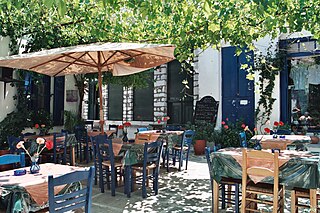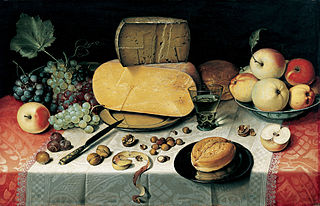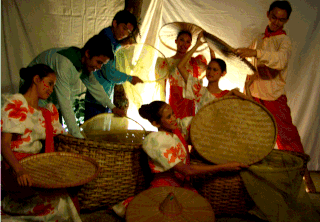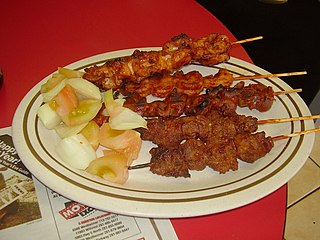
Greek cuisine is a Mediterranean cuisine. Greek cookery makes wide use of vegetables, olive oil, grains, fish, wine, and meat. Other important ingredients include olives, pasta, cheese, lemon juice, herbs, bread, and yogurt. The most commonly used grain is wheat; barley is also used. Common dessert ingredients include nuts, honey, fruits, and filo pastries. It has a history of thousands of years with dishes originating from Ancient Greece, continuing into the Byzantine period and surviving until today. It has been influenced by Middle Eastern, Ottoman and Italian cuisine and cuisines from the northern countries while also having exerted influence over these same areas throughout the years.

Breakfast is the first meal of a day. The word in English refers to breaking the fasting period of the previous night. There is a strong likelihood for one or more "typical", or "traditional", breakfast menus to exist in most places, but their composition varies widely from place to place, and has varied over time, so that globally a very wide range of preparations and ingredients are now associated with breakfast.

Puerto Rican cuisine has its roots in the cooking traditions and practices of Europe, Africa and the native Taínos. Starting from the latter part of the 19th century. Puerto Rican cuisine can be found in several other countries.

Scrambled eggs is a dish made from eggs stirred or beaten together in a pan while being gently heated, typically with salt, butter and sometimes other ingredients.

Eggs Benedict is an American breakfast or brunch dish, an open-faced sandwich consisting of two halves of an English muffin topped with a poached egg, bacon or ham, and hollandaise sauce. The dish was first popularized in New York City.

Trinidad and Tobago cuisine reflects a fusion of African, Creole, Indian-South Asian, Chinese, Amerindian, Arab, European, and Latin American-Spanish-Portuguese cuisines.

Bulgarian cuisine is a representative of the cuisine of Southeast Europe. It shares characteristics with other Balkan cuisines. Bulgarian cooking traditions are diverse because of geographical factors such as climatic conditions suitable for a variety of vegetables, herbs and fruit. Aside from the vast variety of local Bulgarian dishes, Bulgarian cuisine shares a number of dishes with Persian, Turkish, and Greek cuisine.

Filipino cuisine is composed of the cuisines of more than a hundred distinct ethno-linguistic groups found throughout the Philippine archipelago. However, a majority of mainstream Filipino dishes that compose Filipino cuisine are from the cuisines of the Ilocano, Pangasinan, Kapampangan, Tagalog, Bicolano, Visayan, Chavacano and Maranao ethno-linguistic groups. The style of food making and the food associated with it have evolved over many centuries from their Austronesian origins to a mixed cuisine of Indian, Chinese, Spanish and American influences, in line with the major waves of influence that had enriched the cultures of the archipelago, as well as others adapted to indigenous ingredients and the local palate.

New Mexican cuisine is the cuisine of the Southwestern US state of New Mexico, the region is primarily known for its fusion of Pueblo Native American with Hispano Spanish and Mexican cuisine originating in Nuevo México. This cuisine had adaptions and influences throughout its history, including early on from the nearby Apache, Navajo, and throughout New Spain and the Spanish Empire, also from French, Italian, Mediterranean, Portuguese cuisine, and European cafés, furthermore during the American territorial phase from cowboy chuckwagons and Western saloons, additionally after statehood from Route 66 American diners, fast food restaurants, and global cuisine. Even so, New Mexican cuisine developed in fairly isolated circumstances, which has allowed it to maintain its indigenous, Spanish, and Mexican identity, and is therefore not like any other Latin food originating in the contiguous United States.

Czech cuisine has both influenced and been influenced by the cuisines of surrounding countries and nations. Many of the cakes and pastries that are popular in Central Europe originated within the Czech lands. Contemporary Czech cuisine is more meat-based than in previous periods; the current abundance of farmable meat has enriched its presence in regional cuisine. Traditionally, meat has been reserved for once-weekly consumption, typically on weekends. The body of Czech meals typically consists of two or more courses; the first course is traditionally soup, the second course is the main dish, and the third course can include supplementary courses, such as dessert or compote. In the Czech cuisine, thick soups and many kinds of sauces, both based on stewed or cooked vegetables and meats, often with cream, as well as baked meats with natural sauces (gravies), are popular dishes usually accompanied with beer, especially Pilsner, that Czechs consume the most in the world. Czech cuisine is also very strong in sweet main courses and desserts, a unique feature in European cuisines.

Colombian cuisine is a compound of the culinary traditions of the six main regions within the country. Colombian cuisine varies regionally and is particularly influenced by Indigenous Colombian, Spanish, and African cuisines, with slight Arab influence in some regions. Furthermore, being one of the most biodiverse countries in the world, Colombia has one of the widest variety of available ingredients depending on the region.

Ghanaian cuisine is the cuisine of the Ghanaian people. Ghanaian main dishes are organized around a starchy staple food, with which goes a sauce or soup containing a protein sauce. The main ingredient for the vast majority of soups and stews are tomatoes- canned or fresh tomatoes can be used. As a result, nearly all Ghanaian soups and stews are red or orange in appearance.

Honduran cuisine is a fusion of indigenous (Lenca), Spanish, Caribbean and African cuisines. There are also dishes from the Garifuna people. Coconut and coconut milk are featured in both sweet and savory dishes. Regional specialties include fried fish, tamales, carne asada and baleadas. Other popular dishes include meat roasted with chismol and carne asada, chicken with rice and corn, and fried fish with pickled onions and jalapeños. In the coastal areas and the Bay Islands, seafood and some meats are prepared in many ways, including with coconut milk.

The cuisine of New Jersey is derived from the state's long immigrant history and its close proximity to both New York City and Philadelphia. Due to its geographical location, New Jersey can generally be divided by New York City cuisine in the northern and central parts of the state and Philadelphia cuisine in the southern parts. Restaurants in the state often make use of locally grown ingredients such as asparagus, blueberries, cranberries, tomatoes, corn, and peaches. New Jersey is home to approximately 525 diners, the most of any state. Various foods invented in the state, such as the pork roll, and salt water taffy, remain popular there today.

Georgian cuisine is the traditional cuisine of Georgia. Georgian cuisine has similarities with Persian and Caucasus cuisine. Every region of Georgia has its own distinct style of food preparation. Eating and drinking are important parts of Georgian culture.

Most traditional foods in Guatemalan cuisine are based on Maya cuisine, with Spanish influence, and prominently feature corn, chilies and beans as key ingredients. Guatemala is famously home to the Hass avocado and the birthplace of chocolate, as first created by the Mayans.

Nigerian cuisine consists of dishes or food items from the hundreds of ethnic groups that comprise Nigeria. Like other West African cuisines, it uses spices and herbs with palm or groundnut oil to create deeply flavored sauces and soups. Nigerian feasts are colourful and lavish, while aromatic market and roadside snacks cooked on barbecues or fried in oil are in abundance and varied.

A Bloody Mary is a cocktail containing vodka, tomato juice, and other spices and flavorings including Worcestershire sauce, hot sauces, garlic, herbs, horseradish, celery, olives, salt, black pepper, lemon juice, lime juice and/or celery salt. In the United States, it is usually consumed in the morning or early afternoon, and is popular as a hangover cure.

Garlic sauce is a sauce prepared using garlic as a primary ingredient. It is typically a pungent sauce, with the depth of garlic flavor determined by the amount of garlic used. The garlic is typically crushed or finely diced. Simple garlic sauce is composed of garlic and another ingredient to suspend the tuber via emulsion, such as oil, butter or mayonnaise. Various additional ingredients can be used to prepare the sauce.




























